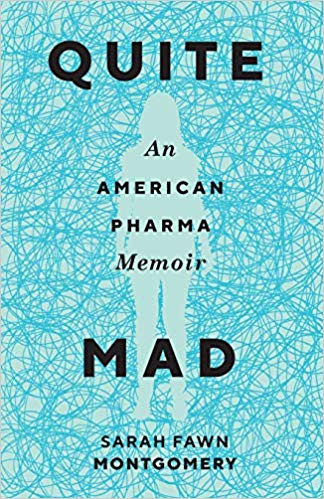Braiding Identity and Mental Health
Quite Mad: An American Pharma Memoir by Sarah Fawn Montgomery
Mad Creek Books (September 21, 2018)
Reviewed by Gabriel Carter
Sarah Fawn Montgomery’s Quite Mad: An American Pharma Memoir places the reader between a myriad of tensions built into the history of mental health. In Quite Mad, Montgomery explores many of these tensions, like the necessity of drugs for many people, the over-prescription of those same drugs, the necessity of mental health services, and the knowledge that many mental health practices arose from sexist and racist contexts. And finally, that while mental health issues do exist and need to be addressed, to “fix” an individual’s condition is to erase the person, turning them from a human being who engages the world differently, to an individual that needs fixing or normalizing. In Montgomery’s own words: “Mental illness is a braided part of identity, impossible to tease out. There is not illness and man, symptom and personality. Like a Venn diagram, they merge and shade one another. To wish illness away is to negate the man himself” (167). The dual identity of symptoms and personality is the crux of Montgomery’s book—a compassionate and intense investigation into the history of mental health and pharmaceuticals, all braided together in the personal memoir of the author.
Individuals and various groups throughout history have been deemed “mad.” Montgomery works to flip the script of “madness” to a narrative more in tune with cultural dialogues that refuse to prescribe away different perspectives. “Madness” makes Montgomery see things, she says, like “spiders, shattered sky, sometimes ghosts standing in the cemetery—but I am grateful for this moment.” “Many cultures experience collective visions of deceased family members, natural and spiritual phenomenon,” she continues, “but Americans label this delusion. Ours is a nation intent on medicating madness away; I feel sorry for those who haven’t experienced the mystical” (216). Madness, Montgomery implores, is not something to completely medicate away; in fact, it can be something that connects one to the mystical, something that America has attempted to eradicate—erasing the individual.
Throughout the work, Montgomery dances between journalistic inquiry and personal memoir. One chapter, she’ll note that “the National Institute of Mental Health reports that 18.1 percent or 42 million Americans live with anxiety disorders, the largest prevalence of mental illness in the country” (xvii). A bit later, journalism melds into personal history, where statistics become lively stories that represent more than numbers; they represent people like Montgomery, whose own story is but one of many—a representative example from an individual with the skill for building connections between herself and the audience.
In all honesty, the beauty in this book would be, and has been, marred by my own words. With that, Montgomery deserves the last words:
I have been told I am crazy, been warned against myself, for a growing portion of my life, yet what for most others defines me as abnormal are the qualities I value most. I would not be without anxiety, without OCD, without PTSD because they have changed the way I see the world. I feel, I think, I am, richer, fuller, and more human because of them. I have been created by my illnesses, but at the same time illness has made me a creator. I have become a storyteller because of my illnesses, have stories to tell because of them, and there is something good and beautiful in that. (268)
GABRIEL CARTER is pursuing a Master’s degree in English Studies at Western Washington University. His research focuses on the intersections of rhetorical theory and philosophy with a particular focus on ethical relations.
Featured image “LIQUISITY” by torbakhopper
